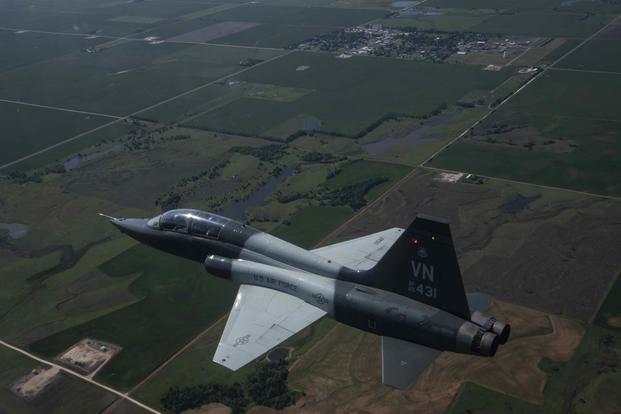Days after a T-38 Talon crash claimed the life of his 23-year-old son on Nov. 21, 2019, Don Wilkie headed to Vance Air Force Base, Oklahoma, to complete the devastating task of claiming his child's body.
Second Lt. Travis B. Wilkie, a student pilot assigned to the 71st Student Squadron at the base, died following a routine training flight in the two-seat trainer jet. He and his instructor pilot, Lt. Col. John "Matt" Kincade, 47, approached the runway for a tandem landing alongside another T-38.
Read Next: US Pilot Killed in Fighter Jet Crash Named; Cause Unclear
Wilkie and Kincade's plane, tail number 65-0395, collided with the second T-38 on the runway, rolled over and skidded to a halt. Kincade, assigned to the 5th Flying Training Squadron, was also killed in the crash.
The Wilkie family puzzled over the accident: How could this happen? How did it all go wrong?
Nearly five months later, Don Wilkie and his wife, Carlene, received news that the U.S. Air Force had concluded its investigation. The Accident Investigation Board report had found Kincade failed to take control of the aircraft, while Wilkie had prematurely used a braking maneuver, known as the aerobrake, after touching down -- precipitating the aircraft's abrupt turn into the nearby trainer.
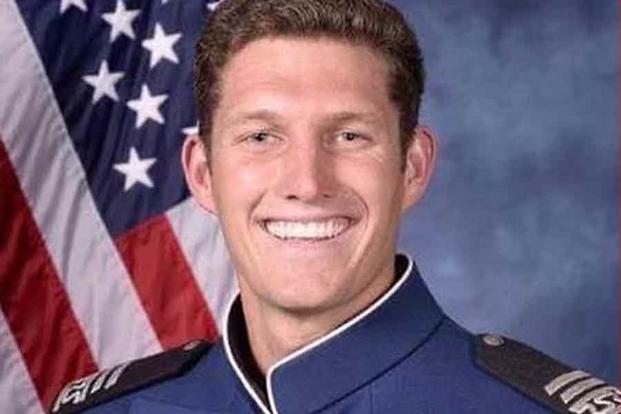
All the Wilkies saw was that the pilots had been saddled with the blame.
Air Education and Training Command on March 5 suspended the use of formation training landing -- when two aircraft coordinate approach and touch down nearly simultaneously, just feet apart -- for its T-38s; officials with the command recently told Military.com the suspension applies to all trainer aircraft, including the single-engine turboprop T-6 Texan II.
"We still perform formation approach training to ensure our pilots have the necessary skills to return to the field in formation, as there are certain emergencies that require this capability," AETC officials said in a statement. "Upon reaching a certain altitude prior to landing, the formations split off for individual sequenced landings."
Prior to this crash, Air Force leaders had already debated ending these sometimes-dangerous formation landings and training -- and some units had already discontinued their use, raising questions about whether the service did not act sooner to mitigate risk.
The Wilkies say they want to ensure formation landings remain permanently banned for the T-38 -- and they also want the service to accelerate production of a new, safer training jet for student pilots.
Regarding the final moments that led up to the catastrophe, there are many questions to which the Wilkies feel they may never get answers. They believe the tragedy was preventable; and while the Air Force is racing to train up more pilots to erase its service-wide shortage, the family said the goal should not be prioritized over safety.
The Air Force "should re-evaluate formation landing with the T-38’s replacement but this exposes the question of why it will [years] to replace the AETC’s principal training aircraft," the family said. "It speaks to the Air Force’s misguided priorities in the midst of a pilot shortage and T-38 student pilot risk."
A Timely Discussion
According to witness testimonies and related documents obtained by Military.com, the director of operations for the 5th Flying Training Squadron said there was a discussion hours before the accident on the operational need for formation landings.
The witness, identified only as a T-38 flight commander, said the Combat Air Forces (CAF) -- those who fly fighters -- have avoided using the maneuver.
"From what I heard, the CAF is not doing them that much anymore," the ops director told investigation board president Brig. Gen. Evan L. Pettus following the crash. "So I don't really understand why we are still doing them. So that's a big question mark in my mind."
Speaking to a pilot adviser, also in the room with Pettus, the director said that, the night before the accident, the commander, Kincade, and another supervisor had a conversation about the landings.
"Interestingly enough, the night before ... [we] were talking about how they need to eliminate formation landings from the syllabus and we were just, I mean, we literally just had that conversation before I went home that night. So it's pretty shocking," the director said. Air Force Magazine also reported on this exchange.
Travis Wilkie’s father also expressed shock to learn of the conversation.
"If your own people are saying [tandem formations] are too dangerous, why wouldn't Air Force leadership respond to that?" Don Wilkie said.
The ops director described Travis Wilkie as someone who would get down on himself if he made a mistake; the director said Wilkie needed to refine his tactics.
During the conversation, the director noted that the syllabus required a maximum of just two to three formation landings.
Travis already had two successful formation landings under his belt, his father said. "So he didn't need to [check off] the requirement."
Kincade's flight and training record was pristine, leaders said.
Inherent Risks
According to a communications transcript, the pilots didn't plan on doing a formation landing when they briefed earlier that day -- but Travis Wilkie was ready to do it.
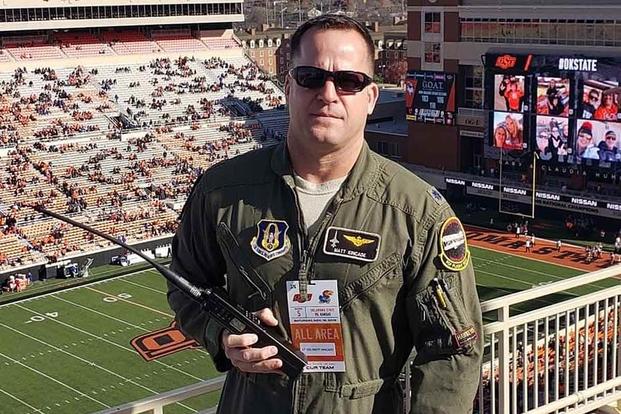
"All right, man, I kinda want to use the gas out here," Kincade said at 8:38 a.m. local time, in reference to saving fuel. "You OK with a formation landing?"
"Yes, sir," Wilkie replied. Roughly 25 minutes later, Wilkie confirmed that the landing gear was good to go.
But something wasn't right.
"Jesus, come on," Wilkie muttered.
Two minutes later: "Get along the horizon," he said over the comms.
Kincade replied: "Yeah, dude, let's get lined up on the runway. How about that?"
Twenty-nine seconds later, Kincade blurted, "Go around!"
Wilkie shouted an expletive at 9:06 a.m.
Nothing more was said prior to the deadly collision.
Officials noted that earlier that morning, there was a low cloud cover, which then steadily lifted. The operations supervisor allowed the T-38s to alter their flight status "from instrument recoveries-only to a visual recovery-permissible status of 'Restricted Pattern -- Straight-In Only'" when coming in for the landing, according to the published report, released May 1.
Prior to the flight, "risk factors identified for the mishap sortie included: two-ship formation, gusty winds forecast above five knots speed," the report said.
The Wilkies felt this detail should have received more scrutiny: Did investigators oversimplify the justification for the concurrent events, while disregarding other factors?
The particular plane that Wilkie and Kincade were flying additionally had a rolling tendency, and received unscheduled maintenance for this lapse months prior, according to the May 1 AIB report.
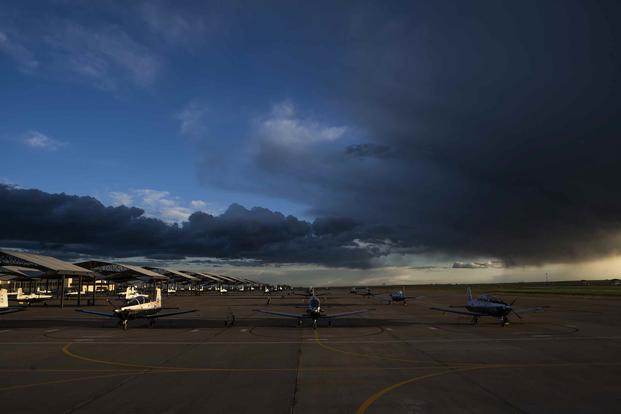
"When he raised the nose to try to get the plane to slow down, you know he's dealing with gusting winds," Don Wilkie said. "And he's sharing a runway."
The observed weather at Vance near the time of the mishap had surface winds coming in from the north at 16 knots, gusting to 22 knots, the report noted.
A former T-38 instructor pilot, who asked not to be identified because they are not authorized to speak on the topic, told Military.com these kinds of winds are typical for Vance.
"The winds were 16 knots gusting to 22, but blowing almost straight down the runway -- no crosswind," the pilot said. "[This is] pretty normal for Vance."
The Push to Ditch Formation Landings
Don Wilkie spent hours poring over the report.
Current and former pilots reached out to him to express condolences and offered guidance. Some pilots who contacted the Wilkie family said they never had to practice a formation landing in flight training, while others said they did. Wilkie questioned the necessity of the practice, since every pilot wasn't required to learn the skill.
Leadership at Vance even advocated getting rid of the landings.
"Form landings aren't needed in the Combat Air Force, [so] why are we still doing them?" the 5th Flying Training Squadron commander said in the witness testimonials.
The former T-38 instructor pilot who spoke on background said that tandem formation landings give pilots more options in unplanned situations.
In an emergency, such as an uncontrolled descent or during inclement weather, which can obstruct line of sight, a pilot could look to the wingman in his periphery to gain perception and properly touch down on the flight line.
"You don't want to land by yourself [for these reasons]," the former T-38 pilot said. "It's a very important skill to have … especially before flying a single-seat airplane by yourself."
"Most people will go through their entire career flying airplanes and never have to do a real formation landing ever -- it is extremely rare," a former F-15 Eagle pilot affiliated with the F-15 schoolhouse in Kingsley Field, Oregon, told Military.com. The former Eagle pilot also asked not to be identified. The pilot said the landing practice had been banned at the schoolhouse, home to the 173rd Fighter Wing, within the last five years.
"We don’t do formation landings because there is no tactical reason for doing so," Lt. Col. Nick Huet, 173rd Fighter Wing director of operations, told Military.com in a statement. "We haven’t done them for many years."
Four years ago, an instructor pilot was landing an F-15D when the rudder actuator cable -- part of the aircraft’s control system -- had failed, causing the aircraft to leave the runway, Huet said.
"If this had occurred during a formation landing the results would have been catastrophic, and with that risk in mind, our schoolhouse made the decision to eliminate formation landings," he said.
The former F-15 pilot said he had only done one formation landing in 22 years of flying fighters. It was a white-out during a snowstorm, he said, with a student who couldn't find the runway.
Even having experienced that real-life scenario, "the chance of needing to really do that in a long career is so rare that it's probably not worth the risk of practicing that on a day-to-day basis," the pilot said. He added that a more efficient way to assist a pilot in distress with landing is to do a follow-the-leader approach, stagger behind the leading aircraft and do a flare-and-land -- slowing the rate of descent for a softer touchdown.
Air Combat Command officials confirmed the landing is rarely used. “Formation landings for CAF squadrons are rare and typically only utilized during emergency situations,” spokeswoman Leah Garton said.
Still, officials said, formation training, with few exceptions, “has been taught since the days of the Air Corps.”
The Age of the T-38
The T-38 has been the backbone aircraft of the Air Force's undergraduate pilot training program for decades, training more than 71,000 U.S. and allied pilots.
Its age is no secret -- some planes date to the 1960s -- and pilots have noted the strain and unforgiving tendencies that come with conducting basic maneuvers in the T-38 because of its shape, most notably its stubby wings.
The aircraft performs best at high speeds and is much more challenging to pilots when working on slow-speed fundamental skills, the former T-38 instructor said.
In the witness testimony, Pettus asked another leader, the 25th Flying Training Squadron commander, what the typical expectations are for landing a T-38.
The commander replied, "Sir, they are pretty well documented," and referred to a document, known as "The Road to Wings," which described mishaps in the T-38 fleet.
"It was a, 'Here's how not to kill yourself in a T-38,'" the commander said.
The Air Force is preparing to receive new trainer jets to replace its current Northrop Grumman-made T-38s. In September 2018, the service awarded Boeing Co. a $9.2 billion contract to build its next aircraft for training pilots, known as the T-X program. In 2019, the Air Force rebranded the T-X as the T-7A Redhawk, named in honor of the Tuskegee Airmen.
The first T-7A is expected to be delivered in 2023. The Wilkies said the planned pace of Redhawks’ production "should be doubled" to retire T-38s at a faster rate.
"Everyone who hears the age of these things is perplexed at why the U.S. government cannot get it done -- you would think they would expedite" the work for the T-7A, Don Wilkie said.
In the meantime, the Air Force has been working to keep the T-38 upgraded with avionics and maintenance improvements.
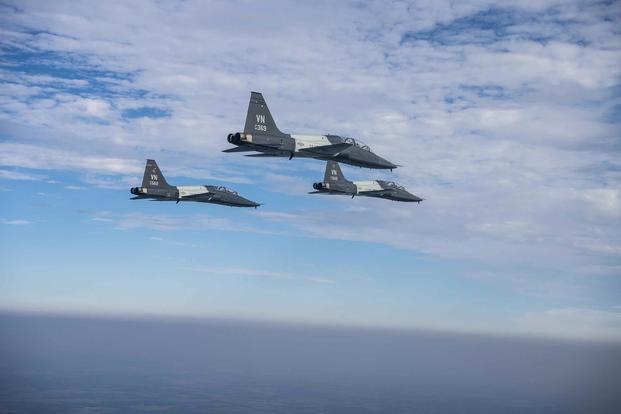
Under one improvement effort, known as the Avionics Upgrade Program, the Air Force began accepting upgraded T-38C models in 2001. The variant received "advanced avionics and has since undergone a programmed service life extension program with updates to the engines, ejection seats and structural components, called PACER CLASSIC," AETC said last month.
"The PACER CLASSIC III program provides upgrades to select structural components on 180 specific T-38C aircraft to enable execution of the AETC pilot training mission throughout the transition period to the T-7A aircraft," it added.
However, officials recently told Military.com that Wilkie and Kincade's plane did not receive the upgrade.
"The mishap aircraft was scheduled to receive this modification in 2024-2025," AETC said. "However, the aircraft condition was determined not to be a factor in the accident."
The Wilkies said that, whether or not the plane's condition was related to the crash, they would have felt better knowing some sort of enhancements had been done to the aging aircraft.
"Improving the capabilities of our aircraft is a basic component of how the Air Force fields effective systems and maintains operational relevancy," AETC said. "The Air Force is proud of its ability to operate and maintain an aging fleet of aircraft. It is our goal to continually provide the most effective training platforms for our nation's Air Force."
Formation Landings May Return
The Wilkies said the old jet’s fuselage, tendency to roll right and other fatigue issues acknowledged in the published report prove that T-38 formation landings are recklessly dangerous.
AETC said it hasn't ruled out bringing back formation landings. The command said the syllabus is regularly adjusted to meet operational requirements, though with the introduction of the F-22 Raptor and F-35 Joint Strike Fighter, which use advanced avionics, the operational need for formation landings has decreased.
"Should the Air Force determine the need to return to formation landing practice in the future, we will again adjust the syllabus," the command said.
"Our primary concern is the safety of our Airmen; however, operating any aircraft carries some risk," the command added. "Air Education and Training Command takes every measure to ensure the safety of our pilots and aircrews, while delivering superior training for our Air Force."
The command held a joint memorial for Kincade and Wilkie on Dec. 5. Wilkie’s mother and sister attended the ceremony, where they met the Kincades and exchanged a few words. Don Wilkie couldn't bring himself to go back.
Recalling his only visit to the base, Don Wilkie said he had met Col. Corey Simmons, the 71st Flying Training Wing commander, as well as Col. Jay Johnson, the vice commander of the 71st FTW.
Simmons, Don said, told him, "We've been trying to replace this airplane [T-38] since 1999."
"I remember that verbatim," he said.
Johnson added that, aerodynamically, the T-38 is a tough airplane. Their words are what sent Don Wilkie on his quest to research the accident more closely.
"That stuck with me. It was something out of their mouths, not something I dreamed up," he said.
While driving in Oklahoma, Don Wilkie noted how his Jeep rumbled and tossed on the road.
"It was really windy that day. Maybe that's just coincidence."
-- Oriana Pawlyk can be reached at oriana.pawlyk@military.com. Follow her on Twitter at @Oriana0214.
Related: Secret Drone Crash, B-1 Engine Malfunction Among Major 2019 Air Force Mishaps
